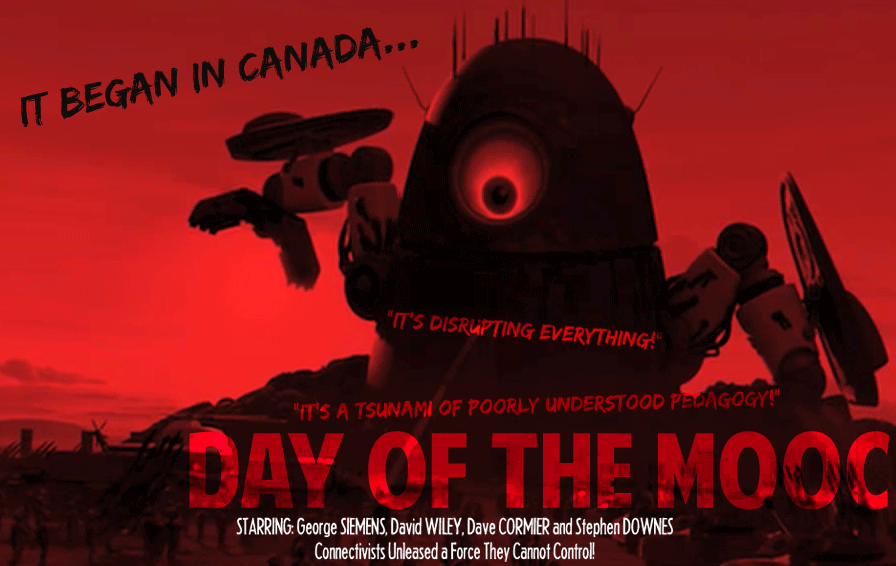The Power of Analogy: MOOCs and Hardware Theory (How Stuff Works)
The Value of the Lens
The value of what we might call “hardware theory” (for this project, this reference is to the collected “How Stuff Works” readings) is both practical as well as theoretical when used as a lens through which to analyze my object of study: a Composition MOOC. In fact, it appears to be a nearly flawless fit, given the overlapping functionality of the vocabulary used to define MOOCs in this instructional video:
“What Is A Mooc?” EdTechReview:
Further, the theory provides concepts that are key to understanding not only the hardware but also the relationships between hardware and software when used to make and exploit connections. These very same concepts often mirror the issues, practices, and structural considerations of an online composition classroom space like a MOOC.
As the image below suggests, a MOOC is not yet a widely accepted educational space or practice. In fact, the tensions and reservations frequently expressed by
those in higher education toward online learning in general (but especially for freshman writing courses) seem to be based most commonly in pedagogical theories (Kolowich). For example, Jones and Singer, in an article to be presented at the 2014 CCCC, make the observation that these tensions exhibited toward educational MOOCs are not just manifestations of “techno-phobia,” but “a conflation of the … model with the whole of the MOOC movement” (1). In other words, the individual writing classroom application is interrogated in the context of a larger trend. While framing the subject in this way seems to drive many of the discussions in our field, and often incorporates a discussion of access-as connectivity, a narrow focus on pedagogical theory may not closely examine network paths as physical / mechanical components that allow such connectivity to take place. Therefore, it may be productive if we first examine this structurally to reemphasize how a MOOC’s networked structure may actually reinforce some of the Compositionist’s pedagogical outcomes (i.e., WPA and NCTE frameworks) as Glance, Forsey, and Riley explore in their article.
The Network as Infrastructure / Space
A MOOC, as the above video describes, is “learning in a networked world” (Cormier), but is in some very basic ways very much like off-line courses in that it involves students, assignments and materials, a facilitator, activities that promote knowledge or data generation, assessment, and an infrastructure or space where this learning and communication take place. Applying a network / hardware lens in order to define this object of study builds upon these pre-existing instructional design systems, frequently using language that carries over from the face-to-face composition classroom (assignments, essays, peer review, due dates, writing process, etc.). Yet, as Cormier states, “a MOOC is not a school; it’s not just an online course. It’s a way to connect and collaborate while developing digital skills.” Interestingly, a MOOC is described not simply in terms of knowledge or skill dissemination; it is described in more dialogic, distributed agency terms. Cormier even describes it as “an event around which people who care about a topic can get together and work and talk about it in a structured way.” Therefore, an additional means of analyzing this educational space is needed, in order to account for the digitally-mediated spaces of access and the means by and degrees to which the technology itself informs and defines this as an object of study.
Another relation to network is also the most obvious: the medium. While initially the term might be read as a reference to the digital nature of the course, the medium might also be explored as a node of communication. For example, Pappano writes that “the lecture” – however brief — is still the most commonly used delivery / pedagogical tool with which to share knowledge. MOOCs frequently deliver course content via short instructor videos, but also may rely on discussion threads (a common feature of Blackboard) or blogs to facilitate connectivity or activities assigned. The home page of Georgia Institute of Technology’s composition MOOC explains that its platform is comprised of a series of instructor-generated videos, along with “recorded ‘Hangout” discussion sessions. These are “complemented by” other, unspecified multimodal materials for assessment and activity.
Borrowing terms from articles found on the site “How Stuff Works” offers a beginning, but there are publications that highlight the usefulness of this analytical approach. For example, Jeffrey Young refers to the means by which the classroom becomes a node of dispersion and connectivity as a “platform,” a term that connotes a physical launching or foundational place upon which the classroom emerges. However, his article refers to a software component (Blackboard) much the same way others might refer to a physical classroom or institution. Thus, this hardware/software “node” of the online learning network structure opens new possibilities of discussion in terms of theorizing digital spaces, from platforms like Blackboard to Facebook, Google Hangout, or online tutoring (Fredette 32).
By incorporating the analogies afforded by such articles as “How PCI Works,” the concept of a bus — defined as “ a channel or path between the components in a computer” (Tyson and Grabianowski) – may serve in some situations as a synonym for a network node, a focal point of transference and intersection. If, as the article states, we understand a bus as a means of connecting all of the vital components of a computer to the primary hub – the central processor – it is possible to extend this powerful analogy to the way an online classroom functions. In the case of a MOOC, this is especially advantageous as the concept of a “serial PCI” may be used to discuss both agency of participants as well as the relationships between nodes. The “serial bus is a one-lane road” (thanks to Leslie Valley’s research into buses for the video), while a parallel bus allows more traffic, in multiple directions. This analogy suggests a means of thinking of the multiple network paths made possible by a MOOC classroom design. Whereas a f2f writing classroom often involves one node of facilitation or direction (the instructor herself), typically in the direction from instructor to student (although in a very effective student-centered design, student-to-student learning also takes place), a composition MOOC may be designed to allow multiple avenues. For example, in the MOOC at Georgia Institute of Technology, the instructor as well as learning center tutors participate in the instruction; conceivably the student-designed multimodal assignments also contribute to the learner-centered knowledge exchange. By thinking of this system of exchange in this way, issues with labor, technology divides, and other areas of tension frequently associated with online learning may be discussed in terms of structural terms.
The structural nature of a network itself provides new ways to interrogate and explore a MOOC as an educational space. Thinking of such a system in terms like routers or switches or modems allows us to focus on the subject of information transfer, which raises the subject of agency. As instructors – whose packets of information may be disseminated through texts or eBooks as well as discussions, videos, web activities, etc. – we must examine how such information delivered from a distance might be transformed by the path and mechanisms of transference. For example, a successful MOOC experience demands that the technology – like a router — “handles the traffic to and from other networks” or nodes in a way that maintains the integrity of the material. But we might also think of the boundaries (which may be how we might see routers) MOOC students must face. What if a student experiences access issues due to technology? Further, routers serve as gatekeepers of information, moving, redirecting, or even halting information between networks. Such a concept resonates strongly among Compositionists, as student access and agency have become bywords for our field over the past several decades. Moreover, using such hardware terms allows us to consider the identity assignment function of a router when discussing issues of digital identity and persona when planning for a Composition MOOC.
In summary, some of the most compelling ideas prompted by this theory when examining my object of study has to do with connectivity, another article found at the “How Stuff Works” resource. In the FYC classroom – whether f2f or online or in a MOOC – the collaborative nature of the course design is an essential element. It is likely safe to state that Compositionists reject the idea of an FYC classroom that follows the Banking Theory model (Friere) that was so prominent in our field’s past. This hardware theory provides powerful, analogous language and imagery with which to explore what is still an emerging topic of study: the MOOC.
References:
Clark, Donald. “MOOC Platforms: A Primer – Biggies, Newbies & Freeboters.” Donald Clark Plan B. 3 Dec. 2013. Web. 5 Feb. 2014.
Franklin, Curt. “How Cable Modems Work.” 20 September 2000. HowStuffWorks.com. Web. 10 February 2014.
Fredette, Michelle. “How To Convert a Classroom Course into a MOOC.” Campus Technology. 27 – 30. 28 Aug. 2013. Web. 6 Feb. 2014.
Glance, David George, Martin Forsey, and Myles Riley. “The Pedagogical Foundations of Massive Open Online Courses.” First Monday 18.5. 6 May 2013. Web. 5 Feb. 2014.
Google Course-Builder. https://code.google.com/p/course-builder/
Head, Karen. “First-Year Composition 2.0.” Georgia Institute of Technology. Coursera.org.
Jones, Sherry and Daniel Singer. CCCC 2014 – “Composition on a New Scale: Game Studies and Massive Open Online Composition.” Forthcoming Presentation, Conference on College Composition and Communication. Mar. 2014. Web. 1 Feb. 2014.
Kolowich, Steve. “Why Some Colleges Are Saying No to MOOC Deals, at Least for Now.” The Chronicle of Higher Education 29 Apr. 2013. Web. 10 Feb. 2014.
McGuire, Robert. “Building A Sense of Community in MOOCs.” Campus Technology. 31-33. 28 Aug. 2013. Web. 6 Feb. 2014.
Pappano, Laura. “The Year of the MOOC.” The New York Times. 2 Nov. 2012. Web. 5 Feb. 2014.
Tastic, Raz. “The Computer Bus.” http://www.youtube.com/watch?v=x6Rw2Q7KPIE
Tyson, Jeff, and Ed Grabianowski. “How PCI Works.” 2 May 2001. HowStuffWorks.com. 10 February 2014.
White, Joshua. “The Ultimate Student Guide to Navigating the Writing MOOC.” MOOC News & Reviews. 26 June 2013. Web. 1 Feb. 2014.
Young, Jeffrey R. “Blackboard Announces New MOOC Platform.” Wired Campus. 10 July 2013. The Chronicle of Higher Education. Web. 5 Feb. 2014.



